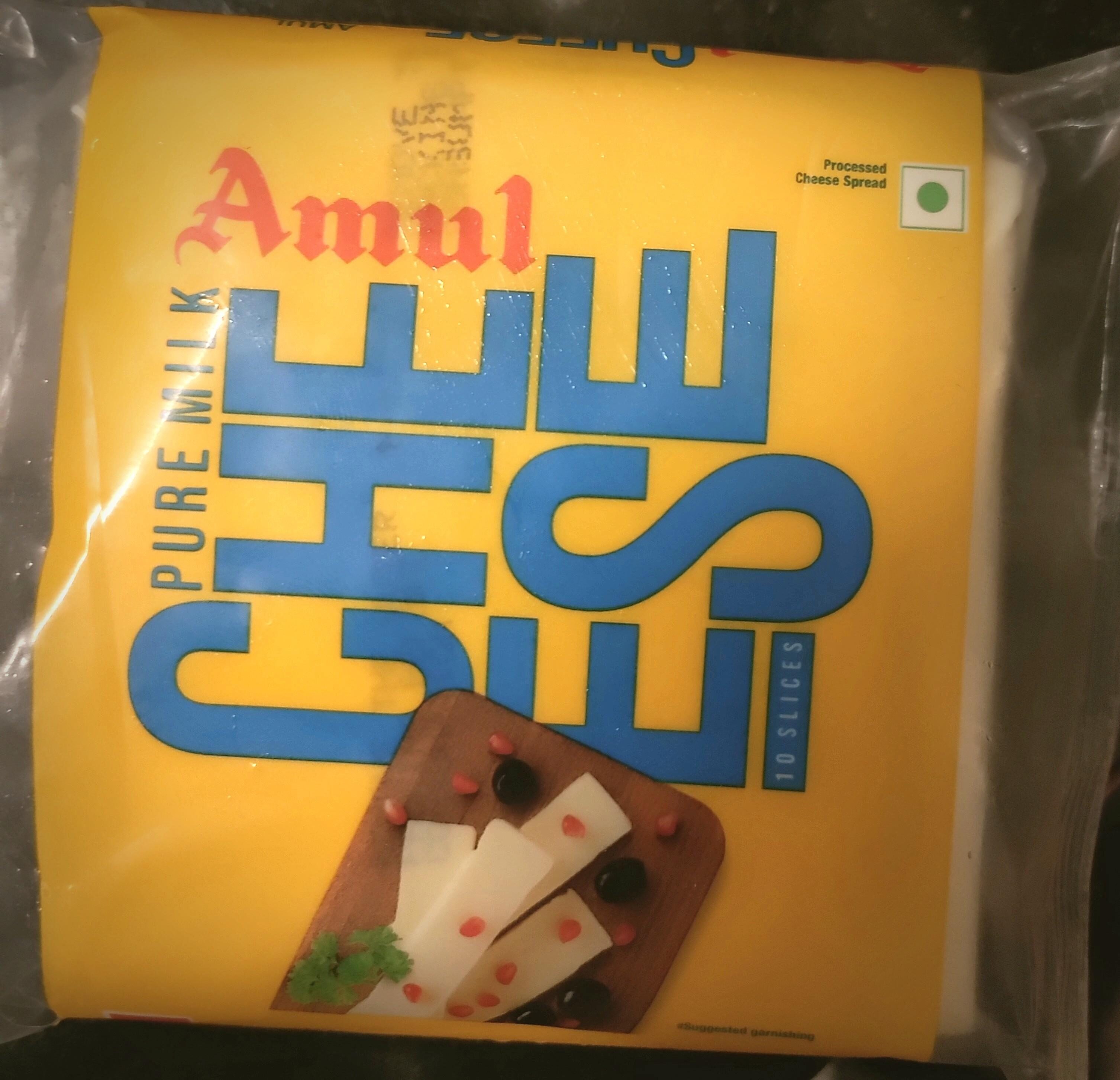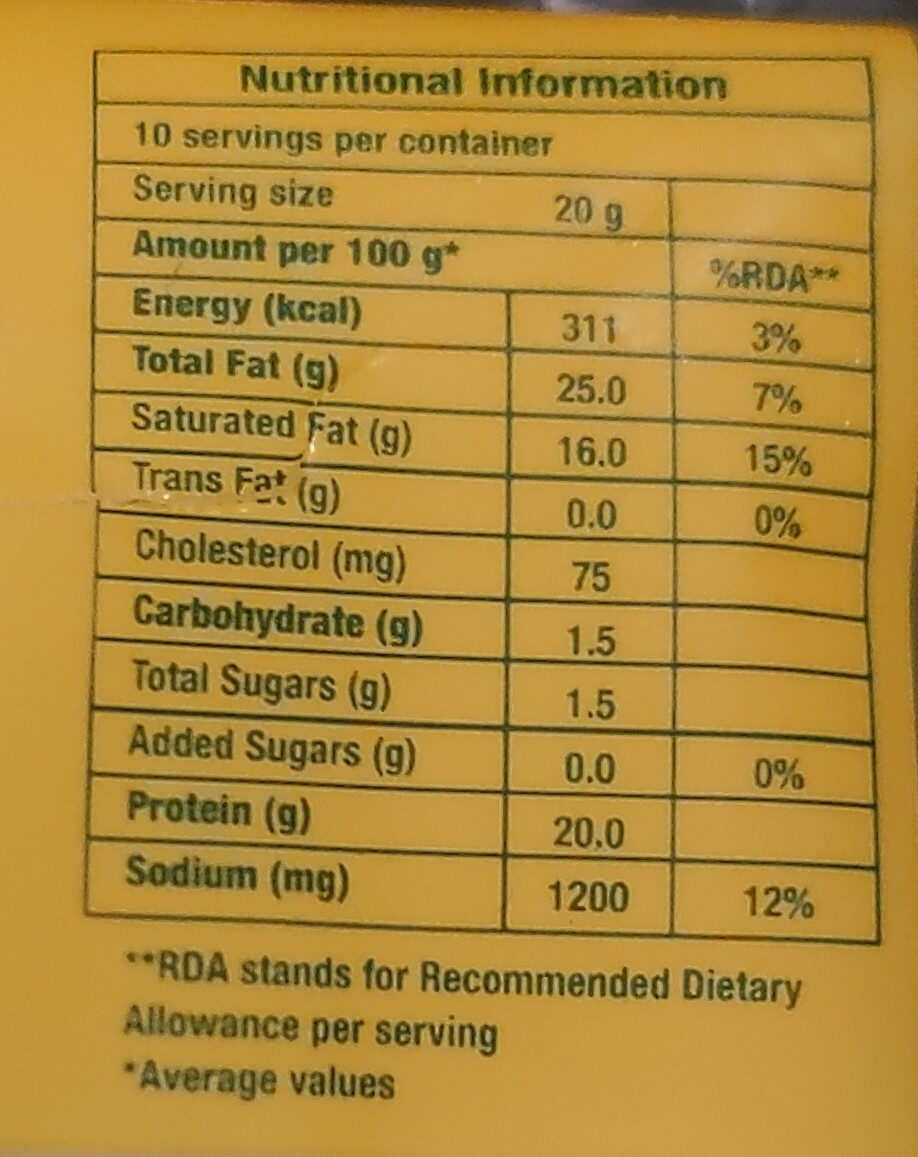Help us make food transparency the norm!
As a non-profit organization, we depend on your donations to continue informing consumers around the world about what they eat.
The food revolution starts with you!
Cheese slices - Amul - 200 g
Cheese slices - Amul - 200 g
This product page is not complete. You can help to complete it by editing it and adding more data from the photos we have, or by taking more photos using the app for Android or iPhone/iPad. Thank you!
×
Barcode: 8901262020015 (EAN / EAN-13)
Common name: Cheese slices
Quantity: 200 g
Packaging: Plastic
Brands: Amul
Categories: Dairies, Fermented foods, Fermented milk products, Cheeses, Processed cheese, Processed cheese in slices
Labels, certifications, awards:
Vegetarian, Green Dot India
Origin of ingredients: India
Link to the product page on the official site of the producer: https://amul.com/products/amul-processed...
Countries where sold: India
Matching with your preferences
Health
Ingredients
-
11 ingredients
Cheese, milk solids, emulsifying salts (452, 339, 341, 331), iodized salt, class II preservatives (200, 234).Allergens: Milk
Food processing
-
Ultra processed foods
Elements that indicate the product is in the 4 - Ultra processed food and drink products group:
- Additive: E452 - Polyphosphates
Food products are classified into 4 groups according to their degree of processing:
- Unprocessed or minimally processed foods
- Processed culinary ingredients
- Processed foods
- Ultra processed foods
The determination of the group is based on the category of the product and on the ingredients it contains.
Additives
-
E200 - Sorbic acid
Sorbic acid: Sorbic acid, or 2‚4-hexadienoic acid, is a natural organic compound used as a food preservative. It has the chemical formula CH3-CH-4CO2H. It is a colourless solid that is slightly soluble in water and sublimes readily. It was first isolated from the unripe berries of the Sorbus aucuparia -rowan tree-, hence its name.Source: Wikipedia
-
E234 - Nisin
Nisin: Nisin is a polycyclic antibacterial peptide produced by the bacterium Lactococcus lactis that is used as a food preservative. It has 34 amino acid residues, including the uncommon amino acids lanthionine -Lan-, methyllanthionine -MeLan-, didehydroalanine -Dha-, and didehydroaminobutyric acid -Dhb-. These unusual amino acids are introduced by posttranslational modification of the precursor peptide. In these reactions a ribosomally synthesized 57-mer is converted to the final peptide. The unsaturated amino acids originate from serine and threonine, and the enzyme-catalysed addition of cysteine residues to the didehydro amino acids result in the multiple -5- thioether bridges. Subtilin and epidermin are related to nisin. All are members of a class of molecules known as lantibiotics. In the food industry, nisin is obtained from the culturing of L. lactis on natural substrates, such as milk or dextrose, and it is not chemically synthesized. It was originally isolated in the late 1930s, and produced since the 1950s as Nisaplin from naturally occurring sources by Aplin and Barrett in laboratories in Beaminster in Dorset, and approved as an additive for food use in the USA in the late 1960s, although the Beaminster factory now is owned by DuPont.Source: Wikipedia
-
E331 - Sodium citrates
Sodium citrate: Sodium citrate may refer to any of the sodium salts of citrate -though most commonly the third-: Monosodium citrate Disodium citrate Trisodium citrateThe three forms of the salt are collectively known by the E number E331. Sodium citrates are used as acidity regulators in food and drinks, and also as emulsifiers for oils. They enable cheeses to melt without becoming greasy.Source: Wikipedia
-
E339 - Sodium phosphates
Sodium phosphates: Sodium phosphate is a generic term for a variety of salts of sodium -Na+- and phosphate -PO43−-. Phosphate also forms families or condensed anions including di-, tri-, tetra-, and polyphosphates. Most of these salts are known in both anhydrous -water-free- and hydrated forms. The hydrates are more common than the anhydrous forms.Source: Wikipedia
-
E341 - Calcium phosphates
Calcium phosphate: Calcium phosphate is a family of materials and minerals containing calcium ions -Ca2+- together with inorganic phosphate anions. Some so-called calcium phosphates contain oxide and hydroxide as well. They are white solids of nutritious value.Source: Wikipedia
Ingredients analysis
-
Palm oil content unknown
Unrecognized ingredients: 452, 339, 341, 331, Class-ii-preservatives, 200, 234Some ingredients could not be recognized.
We need your help!
You can help us recognize more ingredients and better analyze the list of ingredients for this product and others:
- Edit this product page to correct spelling mistakes in the ingredients list, and/or to remove ingredients in other languages and sentences that are not related to the ingredients.
- Add new entries, synonyms or translations to our multilingual lists of ingredients, ingredient processing methods, and labels.
If you would like to help, join the #ingredients channel on our Slack discussion space and/or learn about ingredients analysis on our wiki. Thank you!
-
Non-vegan
Non-vegan ingredients: Cheese, Milk solidsSome ingredients could not be recognized.
We need your help!
You can help us recognize more ingredients and better analyze the list of ingredients for this product and others:
- Edit this product page to correct spelling mistakes in the ingredients list, and/or to remove ingredients in other languages and sentences that are not related to the ingredients.
- Add new entries, synonyms or translations to our multilingual lists of ingredients, ingredient processing methods, and labels.
If you would like to help, join the #ingredients channel on our Slack discussion space and/or learn about ingredients analysis on our wiki. Thank you!
-
Vegetarian
No non-vegetarian ingredients detected
Unrecognized ingredients: 452, 339, 341, 331, Class-ii-preservatives, 200, 234Some ingredients could not be recognized.
We need your help!
You can help us recognize more ingredients and better analyze the list of ingredients for this product and others:
- Edit this product page to correct spelling mistakes in the ingredients list, and/or to remove ingredients in other languages and sentences that are not related to the ingredients.
- Add new entries, synonyms or translations to our multilingual lists of ingredients, ingredient processing methods, and labels.
If you would like to help, join the #ingredients channel on our Slack discussion space and/or learn about ingredients analysis on our wiki. Thank you!
-
Details of the analysis of the ingredients
We need your help!
Some ingredients could not be recognized.
We need your help!
You can help us recognize more ingredients and better analyze the list of ingredients for this product and others:
- Edit this product page to correct spelling mistakes in the ingredients list, and/or to remove ingredients in other languages and sentences that are not related to the ingredients.
- Add new entries, synonyms or translations to our multilingual lists of ingredients, ingredient processing methods, and labels.
If you would like to help, join the #ingredients channel on our Slack discussion space and/or learn about ingredients analysis on our wiki. Thank you!
: Cheese, _milk_ solids, emulsifying salts (452, 339, 341, 331), iodized salt, class II preservatives (200, 234)- Cheese -> en:cheese - vegan: no - vegetarian: maybe - ciqual_proxy_food_code: 12999 - percent_min: 20 - percent_max: 100
- _milk_ solids -> en:milk-solids - vegan: no - vegetarian: yes - ciqual_proxy_food_code: 19051 - percent_min: 0 - percent_max: 50
- emulsifying salts -> en:emulsifying-salts - percent_min: 0 - percent_max: 33.3333333333333
- 452 -> en:452 - percent_min: 0 - percent_max: 33.3333333333333
- 339 -> en:339 - percent_min: 0 - percent_max: 16.6666666666667
- 341 -> en:341 - percent_min: 0 - percent_max: 11.1111111111111
- 331 -> en:331 - percent_min: 0 - percent_max: 8.33333333333333
- iodized salt -> en:iodised-salt - vegan: yes - vegetarian: yes - ciqual_food_code: 11058 - percent_min: 0 - percent_max: 3
- class II preservatives -> en:class-ii-preservatives - percent_min: 0 - percent_max: 3
- 200 -> en:200 - percent_min: 0 - percent_max: 3
- 234 -> en:234 - percent_min: 0 - percent_max: 1.5
Nutrition
-
Poor nutritional quality
⚠ ️Warning: the amount of fiber is not specified, their possible positive contribution to the grade could not be taken into account.⚠ ️Warning: the amount of fruits, vegetables and nuts is not specified on the label, it was estimated from the list of ingredients: 0This product is not considered a beverage for the calculation of the Nutri-Score.
Positive points: 5
- Proteins: 5 / 5 (value: 20, rounded value: 20)
- Fiber: 0 / 5 (value: 0, rounded value: 0)
- Fruits, vegetables, nuts, and colza/walnut/olive oils: 0 / 5 (value: 0, rounded value: 0)
Negative points: 23
- Energy: 3 / 10 (value: 1301, rounded value: 1301)
- Sugars: 0 / 10 (value: 1.5, rounded value: 1.5)
- Saturated fat: 10 / 10 (value: 16, rounded value: 16)
- Sodium: 10 / 10 (value: 1200, rounded value: 1200)
The points for proteins are counted because the product is in the cheeses category.
Nutritional score: (23 - 5)
Nutri-Score:
-
Nutrient levels
-
Fat in high quantity (25%)
What you need to know- A high consumption of fat, especially saturated fats, can raise cholesterol, which increases the risk of heart diseases.
Recommendation: Limit the consumption of fat and saturated fat- Choose products with lower fat and saturated fat content.
-
Saturated fat in high quantity (16%)
What you need to know- A high consumption of fat, especially saturated fats, can raise cholesterol, which increases the risk of heart diseases.
Recommendation: Limit the consumption of fat and saturated fat- Choose products with lower fat and saturated fat content.
-
Sugars in low quantity (1.5%)
What you need to know- A high consumption of sugar can cause weight gain and tooth decay. It also augments the risk of type 2 diabetes and cardio-vascular diseases.
Recommendation: Limit the consumption of sugar and sugary drinks- Sugary drinks (such as sodas, fruit beverages, and fruit juices and nectars) should be limited as much as possible (no more than 1 glass a day).
- Choose products with lower sugar content and reduce the consumption of products with added sugars.
-
Salt in high quantity (3%)
What you need to know- A high consumption of salt (or sodium) can cause raised blood pressure, which can increase the risk of heart disease and stroke.
- Many people who have high blood pressure do not know it, as there are often no symptoms.
- Most people consume too much salt (on average 9 to 12 grams per day), around twice the recommended maximum level of intake.
Recommendation: Limit the consumption of salt and salted food- Reduce the quantity of salt used when cooking, and don't salt again at the table.
- Limit the consumption of salty snacks and choose products with lower salt content.
-
-
Nutrition facts
Nutrition facts As sold
for 100 g / 100 mlAs sold
per serving (20g)Compared to: Cheeses Energy 1,301 kj
(311 kcal)260 kj
(62 kcal)+9% Fat 25 g 5 g +9% Saturated fat 16 g 3.2 g +11% Trans fat 0 g 0 g Cholesterol 75 mg 15 mg +13% Carbohydrates 1.5 g 0.3 g -56% Sugars 1.5 g 0.3 g -8% Fiber ? ? Proteins 20 g 4 g +37% Salt 3 g 0.6 g +230% Fruits‚ vegetables‚ nuts and rapeseed‚ walnut and olive oils (estimate from ingredients list analysis) 0 % 0 %
Environment
-
Eco-Score D - High environmental impact
⚠ ️The full impact of transportation to your country is currently unknown.The Eco-Score is an experimental score that summarizes the environmental impacts of food products.→ The Eco-Score was initially developped for France and it is being extended to other European countries. The Eco-Score formula is subject to change as it is regularly improved to make it more precise and better suited to each country.Life cycle analysis
-
Average impact of products of the same category: C (Score: 54/100)
Category: Processed cheese, in slices
Category: Processed cheese, in slices
- PEF environmental score: 0.49 (the lower the score, the lower the impact)
- including impact on climate change: 5.22 kg CO2 eq/kg of product
Stage Impact Agriculture
84.4 %Processing
5.6 %Packaging
4.4 %Transportation
3.3 %Distribution
1.8 %Consumption
0.5 %
Bonuses and maluses
-
Origins of ingredients with a high impact
Malus:
Environmental policy: -5
Transportation: 0
Origin of the product and/or its ingredients % of ingredients Impact India 100 %High
-
Packaging with a medium impact
Malus: -10
Shape Material Recycling Impact Unknown Plastic High ⚠ ️ The information about the packaging of this product is not sufficiently precise (exact shapes and materials of all components of the packaging).⚠ ️ For a more precise calculation of the Eco-Score, you can modify the product page and add them.
If you are the manufacturer of this product, you can send us the information with our free platform for producers.
Eco-Score for this product
-
Impact for this product: D (Score: 39/100)
Product: Cheese slices - Amul - 200 g
Life cycle analysis score: 54
Sum of bonuses and maluses: -10
Final score: 39/100
-
Carbon footprint
-
Equal to driving 2.7 km in a petrol car
522 g CO² per 100g of product
The carbon emission figure comes from ADEME's Agribalyse database, for the category: Processed cheese, in slices (Source: ADEME Agribalyse Database)
Stage Impact Agriculture
85.1 %Processing
5.0 %Packaging
5.0 %Transportation
4.0 %Distribution
0.7 %Consumption
0.1 %
Packaging
-
Packaging with a medium impact
-
Packaging parts
(Plastic)
-
Packaging materials
Material % Packaging weight Packaging weight per 100 g of product Plastic
-
Transportation
-
Origins of ingredients
Origins of ingredients with a high impact
Origin of the product and/or its ingredients % of ingredients Impact India 100 %High
Report a problem
-
Incomplete or incorrect information?
Category, labels, ingredients, allergens, nutritional information, photos etc.
If the information does not match the information on the packaging, please complete or correct it. Open Food Facts is a collaborative database, and every contribution is useful for all.
Data sources
Product added on by matiz
Last edit of product page on by mudskipper875.
Product page also edited by ecoscore-impact-estimator, openfoodfacts-contributors, packbot.










